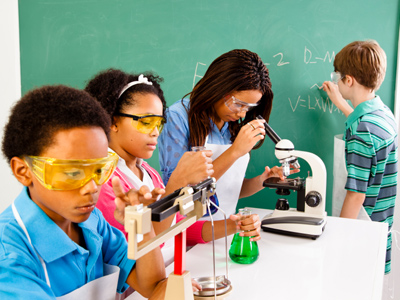
What is a compound? Find out in this educational quiz.
Compounds 01
This is an enjoyable way to test your knowledge about molecules and chemical elements.
Between the ages of 11 and 14 our quizzes are invaluable.
Scroll down to play the quiz
1 .
A compound is a substance which contains .......
only one type of atom
only two types of atom
two or more chemicals which can be easily separated
two or more elements chemically joined together
In theory, the elements could be separated using chemical reactions but that is not always straightforward
2 .
The number of different elements in calcium carbonate (CaCO3) is .......
2
3
4
5
The easy way to do this is to count the capital letters in the formula. Each element has exactly ONE capital letter. In CaCO3, the three elements are Ca, C and O
3 .
Which of the following could have been formed by reacting iron with sulfur?
Iron oxide
Sulfuric iron
Iron sulfide
Sulfuric acid
There are two elements joining together so the name ends in -ide
4 .
The formula of methane is CH4. Which of these is true?
A molecule of methane contains five atoms
A molecule of methane contains five different elements
An atom of methane contains two different elements
Methane contains five molecules
It contains one atom of carbon joined to four atoms of hydrogen. Can you see how you get that from the formula?
5 .
Which of these is NOT a compound?
Carbon monoxide
Chlorine
Hydrochloric acid
Propane
Chlorine is an element and therefore appears on the periodic table. The others do not appear on the periodic table so they cannot possibly be elements
6 .
How many atoms in the formula CuSO4?
3
4
6
7
One Cu, one S, four O. If you find reading formulae difficult, don't worry, you will have plenty more practice when you study science at GCSE. There are some simple rules that need to be learned, not everyone sees them straight away
7 .
The correct formula for carbon tetrachloride is .......
C3Cl
C4Cl
CCl3
CCl4
The clue is in the word tetra - that means four and since it is in front of the 'chloride' bit of the name, there must be four chlorine atoms involved
8 .
The smallest particle of carbon dioxide (CO2) that still has the properties of carbon dioxide is called .......
a molecule
a proton
an atom
an ion
Remember, compounds that are made from two non-metals joined together exist as molecules
9 .
Which of these word equations is INCORRECT?
Copper + oxygen → copper oxide
Hydrogen + chlorine → hydrogen chlorine
Iron + chlorine → iron chloride
Magnesium + oxygen → magnesium oxide
Whoever wrote it forgot to change the name of chlorine to chloride in the compound
10 .
Which is the correct formula equation?
Mg + O → MgO
Mg + O2 → MgO2 →
2 Mg + O2 → Mg2O2
2 Mg + O2 → 2 MgO
If you count up the number of atoms on each side of the equation, they are the same - two of magnesium and two of oxygen
**Unlimited Quizzes Await You! 🚀**
Hey there, quiz champ! 🌟 You've already tackled today's free questions.
Ready for more?
Ready for more?
🔓 Unlock UNLIMITED Quizzes and challenge yourself every day. But that's
not all...
not all...
🔥 As a Subscriber you can join our thrilling "Daily Streak" against other
quizzers. Try to win a coveted spot on our Hall of Fame Page.
quizzers. Try to win a coveted spot on our Hall of Fame Page.
Don't miss out! Join us now and keep the fun rolling. 🎉
**Unlimited Quizzes Await You! 🚀**
Hey there, quiz champ! 🌟 You've already tackled today's free questions. Ready for more?
🔓 Unlock UNLIMITED Quizzes and challenge yourself every day. But that's not all...
🔥 As a Subscriber you can join our thrilling "Daily Streak" against other quizzers. Try to win a coveted spot on our Hall of Fame Page.
Don't miss out! Join us now and keep the fun rolling. 🎉







